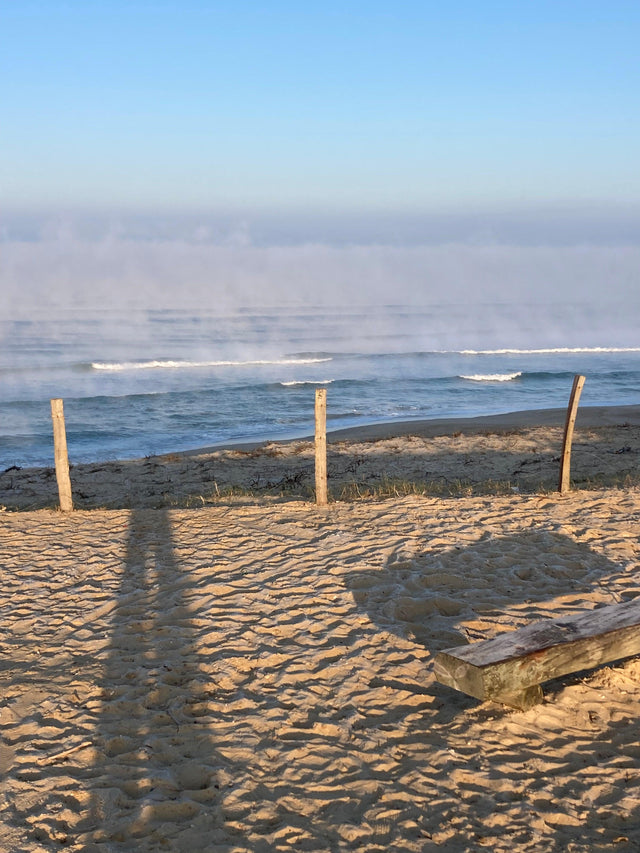Freezing Waves, Maximum Heat: Demystifying winter water sports
Winter doesn't stop water sports enthusiasts, but it does bring its share of challenges. Whether you're into winter surfing, winter kiting, winter winging or stand-up paddling (SUP), it's essential to adopt the right reflexes to get the most out of your winter sessions. In this article, we'll explore the habits to adopt, the preparation needed, the ideal session time and what to do after getting out of the water.
1. Preparation before the session
Before you embark on your winter sessions, good preparation is the key to a successful experience. Make sure you :
- Choose the Right Wetsuit: As wetsuit specialists, Saint Jacques Wetsuits offers quality equipment suitable for winter water sports. Choose a wetsuit adapted to the water temperature to stay warm throughout your session. Premium Japanese Yamamoto neoprene will be your best ally against the cold. In France, a thickness of between 5mm and 3mm will generally do the trick, for water temperatures below 14°.

- Cover your extremities: A lot of heat is lost in this area. Make sure you wear surf gloves or open-palmed gloves for wind sports, a chapka neoprene cap or beanie neoprene for the head and a good pair of booties. A fullsuit hooded convertible is a popular option for winter sports specialists. We recommend wearing earplugs to prevent exostosis

- Use an appropriate underlayer: Don't take any chances if you're in any doubt, base layers are thermal tank tops that you put under your suit to increase the heat. The advantage is that they don't restrict the mobility of the suit around the arms. On the other hand, don't use lycra because it holds moisture against your skin.

- Proper warm-up: Take the time to warm up properly. Cold muscles are more prone to injury, so do some dynamic stretching to prepare your body for the specific movements of your sport. Be careful when it's really cold: warming up on the beach is like... getting cold.
- Equipment check: Inspect your equipment carefully before each winter session. Make sure everything is in good working order, from the lines on your kite to the fins on your surfboard. Now is not the time for your leash to break off the shore! Bear in mind that you're going to be a little heavier than usual, so adjust the volume of your board, for example.
- Get your body used to the cold: Do more outings in cold weather to get your body used to it and increase your tolerance to the cold. Why not go for a sea walking from time to time when the wind and waves aren't blowing?
2. Session time management
In winter, the length of your sessions may vary depending on the weather conditions, but they are generally shorter than in summer. Here are a few tips:
- Choose the best time slots: Opt for sessions in the middle of the day when the temperature is milder. Avoid the coldest hours of the morning and evening.
- Analyse the spot and its conditions carefully: Stay informed about the weather conditions (tides, wind). Forecasts can change rapidly in winter, so make sure you know what's forecast before you go. Read the blog post on this subject.

- Ride with your mates: The group effect is very important for motivation. More fun and more security.
- Stay active in the water: Getting started is always tricky, but don't rush. Breathe calmly and enjoy yourself, as there are generally far fewer people in the water. Keep moving to conserve heat. When you can't warm up any more, it's time to get out. It's normal for winter sessions to be shorter because you burn off more energy.
- Quick exit strategy: Get out of the water before you feel cold or tired. Numbness and shivering are the warning signs of hypothermia. Have a plan for getting out of the water quickly if you need to, with everything you need ready to warm up quickly.
3. At the end of the session
After a winter session, it's crucial to take care of yourself and your equipment. At this stage, you probably can't feel your fingers or toes - that's normal, they'll come back!
- Remove your suit correctly: Remove your suit slowly and carefully to avoid damaging it. Have some hot water ready (in a portable shower or thermos) to pour over the suit before removing it to invigorate the muscles and ensure a comfortable transition. You can use a neoprene mat or a changing bag to avoid direct contact with the ground.
- Hydrate and feed yourself: Winter conditions can be exhausting, so make sure you hydrate and replenish your energy reserves after the session. Now's the time to drink a hot tea prepared beforehand in a thermos.
- A quick, warm change: After getting out of the water, change quickly into warm, easy-to-slip-on clothes. A quality cotton poncho is essential for this transition. If you live less than 15 minutes away by car, we advise you to get home in a wetsuit using a neoprene car seat cover, and change under a hot shower at home.
By adopting these tips and tricks, you'll be able to enjoy your water sports sessions to the full, even in the coldest months of the year. Don't forget that comfort and warmth are synonymous with pleasure. Be ready to face winter with confidence: Winter is here, the Ride goes on.



0 Comments
There are no comments for this article. Be the first one to leave a message!